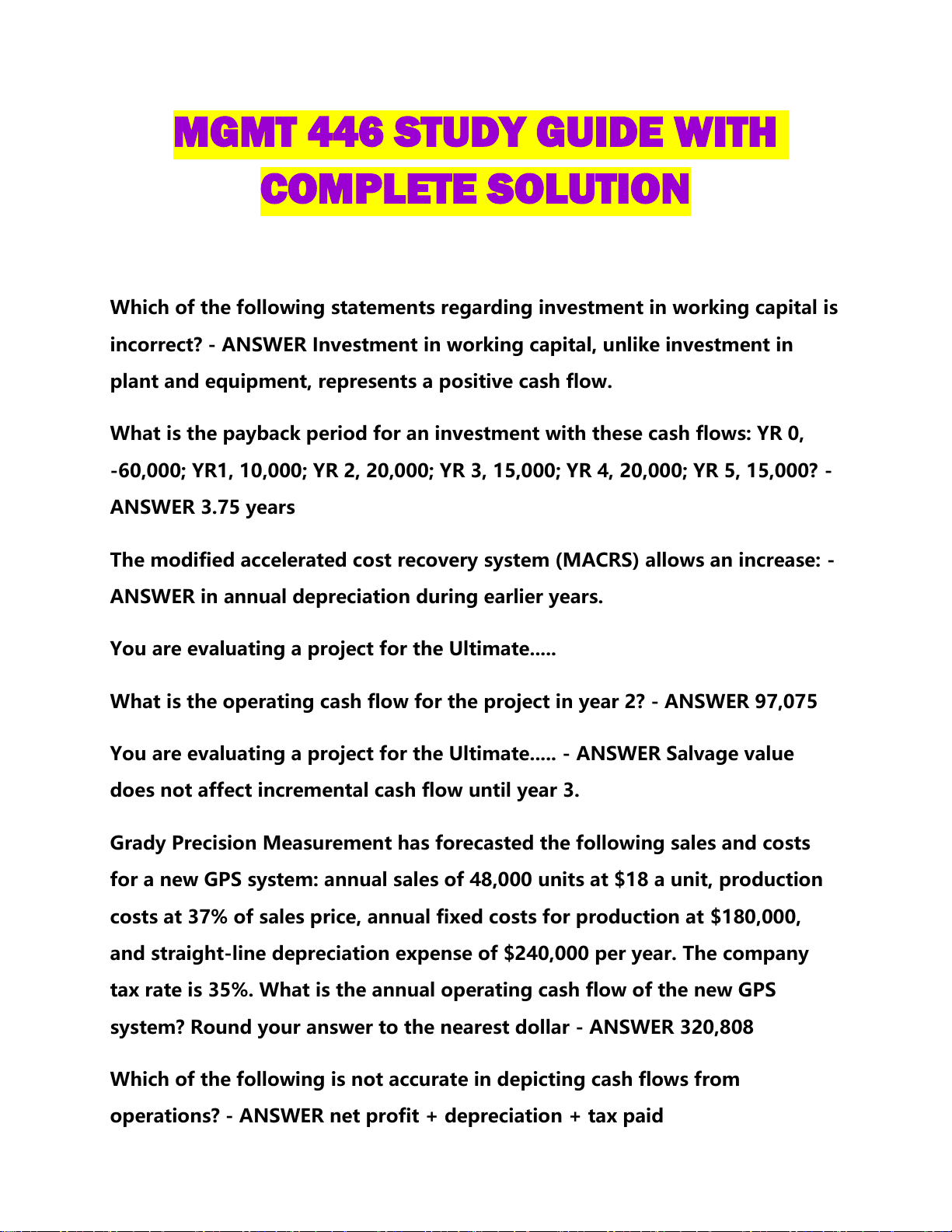
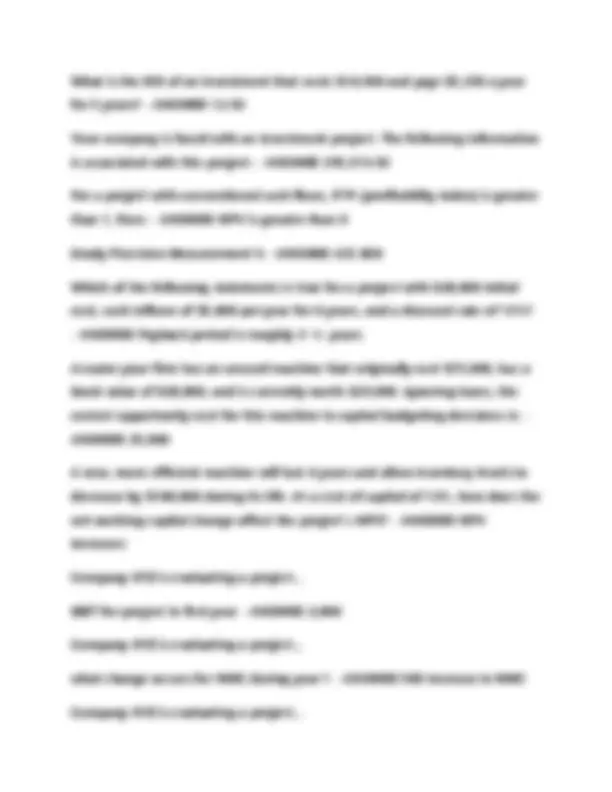
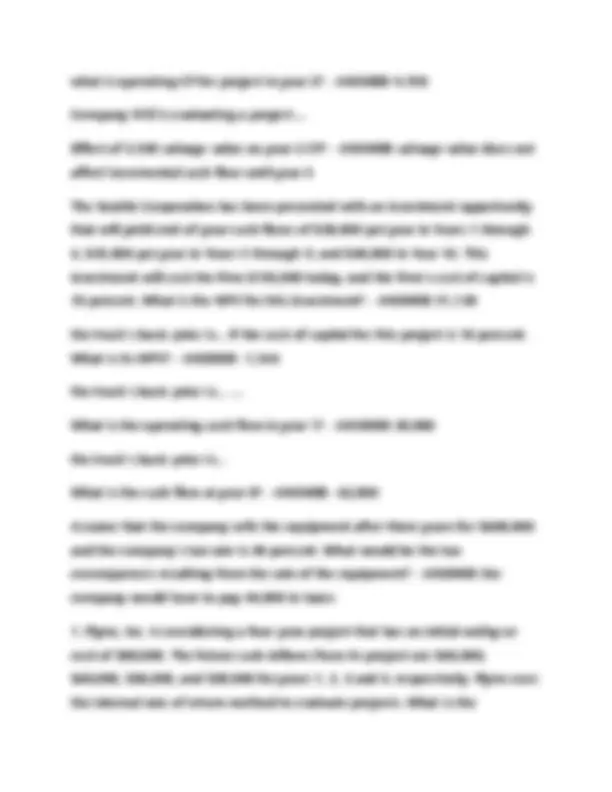

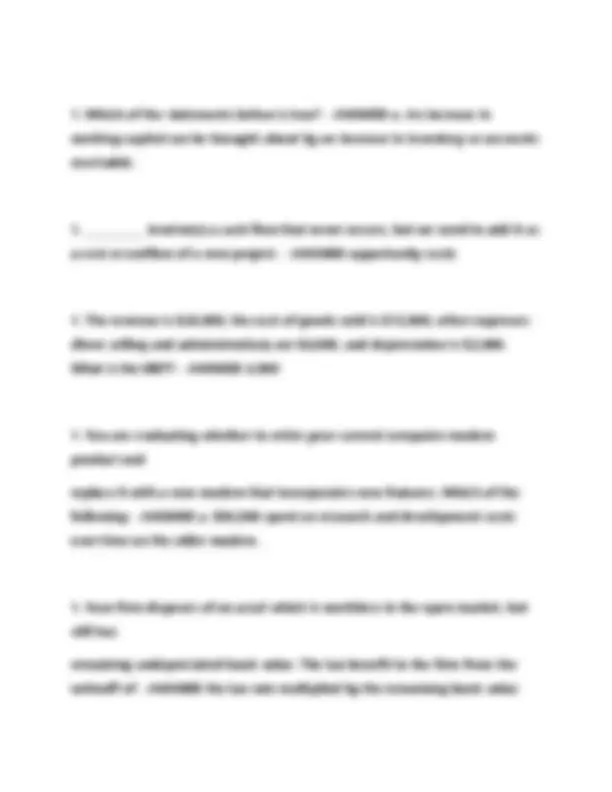
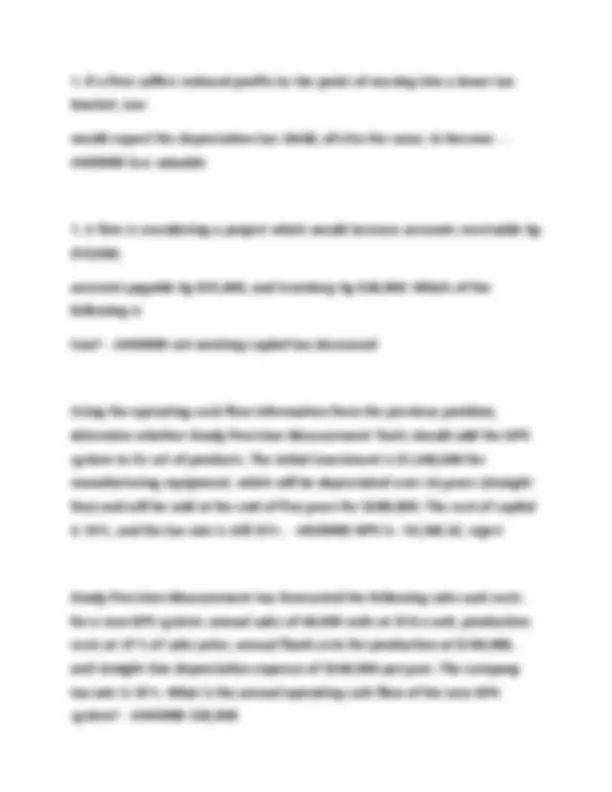
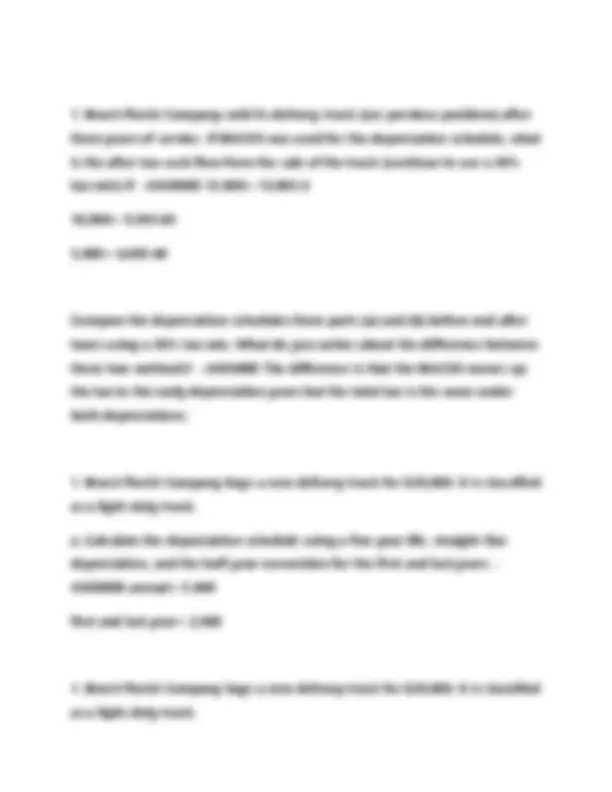
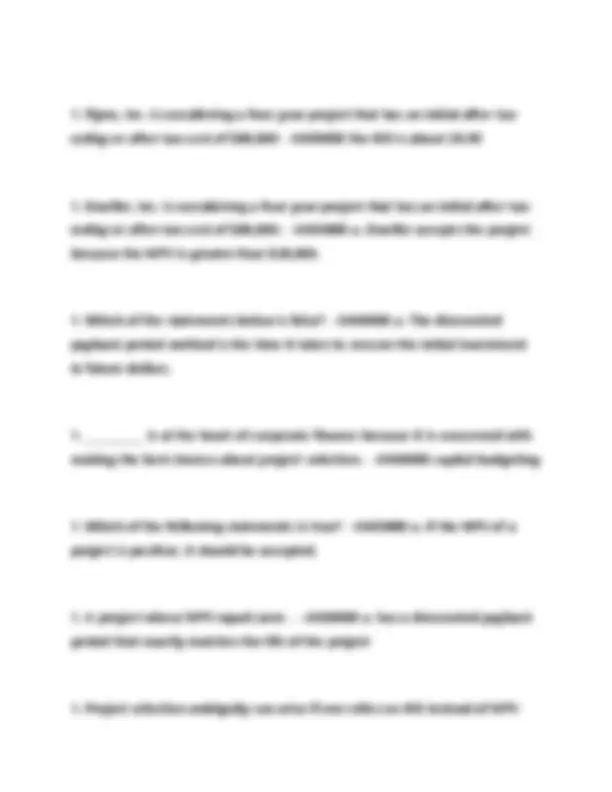
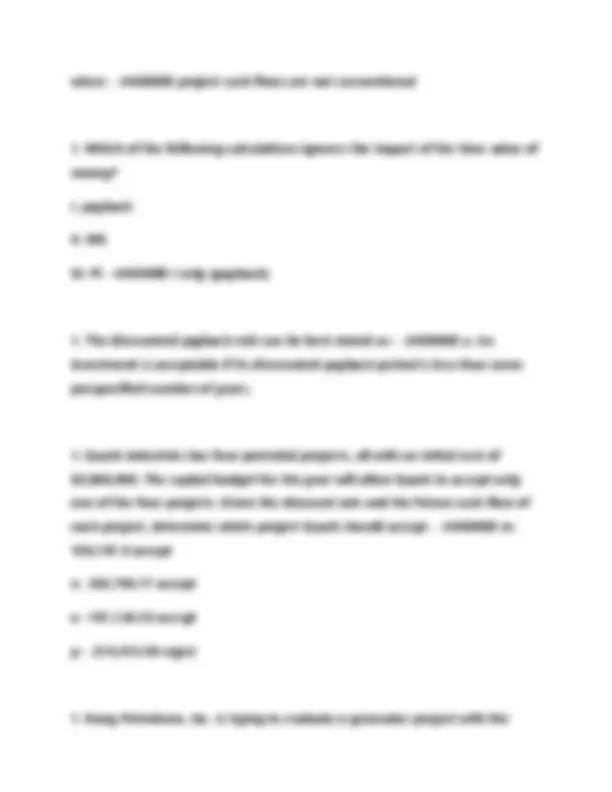
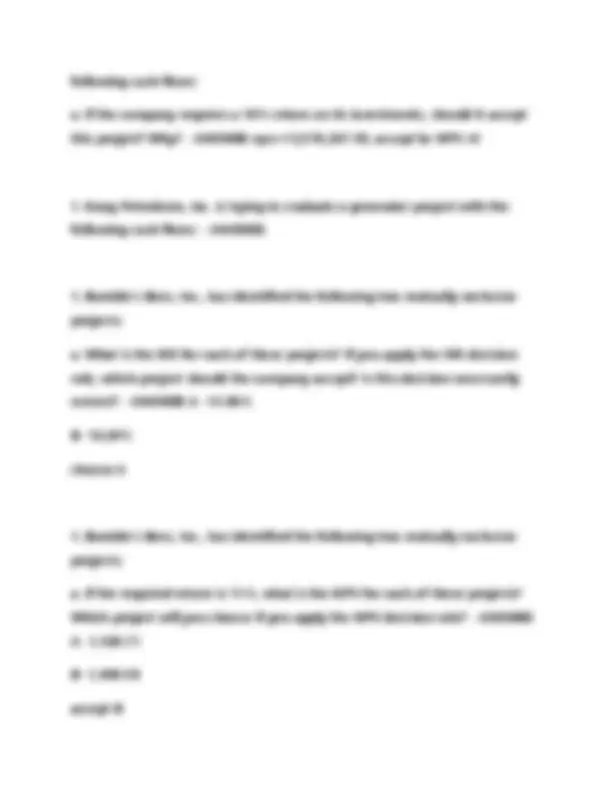


Study with the several resources on Docsity

Earn points by helping other students or get them with a premium plan


Prepare for your exams
Study with the several resources on Docsity

Earn points to download
Earn points by helping other students or get them with a premium plan
Community
Ask the community for help and clear up your study doubts
Discover the best universities in your country according to Docsity users
Free resources
Download our free guides on studying techniques, anxiety management strategies, and thesis advice from Docsity tutors
A comprehensive collection of questions and answers related to capital budgeting techniques, focusing on net present value (npv) and internal rate of return (irr) calculations. it provides practical examples and scenarios to illustrate the application of these methods in evaluating investment projects. The exercises cover various aspects of project appraisal, including cash flow estimation, discount rate selection, and the interpretation of npv and irr results. This resource is valuable for students learning about capital budgeting and financial decision-making.
Typology: Exams
1 / 17

This page cannot be seen from the preview
Don't miss anything!










Which of the following statements regarding investment in working capital is incorrect? - ANSWER Investment in working capital, unlike investment in plant and equipment, represents a positive cash flow.
What is the payback period for an investment with these cash flows: YR 0, -60,000; YR1, 10,000; YR 2, 20,000; YR 3, 15,000; YR 4, 20,000; YR 5, 15,000? - ANSWER 3.75 years
The modified accelerated cost recovery system (MACRS) allows an increase: - ANSWER in annual depreciation during earlier years.
You are evaluating a project for the Ultimate.....
What is the operating cash flow for the project in year 2? - ANSWER 97,
You are evaluating a project for the Ultimate..... - ANSWER Salvage value does not affect incremental cash flow until year 3.
Grady Precision Measurement has forecasted the following sales and costs for a new GPS system: annual sales of 48,000 units at $18 a unit, production costs at 37% of sales price, annual fixed costs for production at $180,000, and straight-line depreciation expense of $240,000 per year. The company tax rate is 35%. What is the annual operating cash flow of the new GPS system? Round your answer to the nearest dollar - ANSWER 320,
Which of the following is not accurate in depicting cash flows from operations? - ANSWER net profit + depreciation + tax paid
Your company is considering investing in a new system that will cost $160,000. In addition, it costs $40,000 to adapt the system to be compatible with existing IT infrastructure and operational. It is estimated that the system will increase sales/revenues by $150,000 annually for Years 1-6. Operating expenses, other than depreciation, are expected to be equal to 60 percent of sales in each year. - ANSWER 225,
What is the NPV of the following set of cash flows if the required return is 15%? - ANSWER 408.
Which of the following statements is most correct? - ANSWER If an asset to be used by a potential project is already owned by the firm, and if that asset could be leased to another firm if the new project were not undertaken, then the net rent that could be obtained should be charged as a cost to the project under consideration.
An investment opportunity, in year 3, is forecast to create revenue of $120,000, and cost of goods sold 40% of revenue. SG&A is expected to be $30,000. Depreciation will be $15,000. Tax rate is 40%. Working capital will increase by $10,000 during year 3. What is net cash flow projected for year 3?
Consider a project with an initial investment and positive future cash flows. As the discount rate is decreased the _____________. - ANSWER IRR remains constant while NPV increases
A firm generates sales of $250,000, depreciation expense of $50,000, taxable income of $50,000, and has a 35% tax rate. By how much does net cash flow deviate from net income? (assume the firm does not have any interest expenses.) - ANSWER 50,
what is operating CF for project in year 2? - ANSWER 9,
Company XYZ is evaluating a project....
Effect of 3,500 salvage value on year 2 CF? - ANSWER salvage value does not affect incremental cash flow until year 3
The Seattle Corporation has been presented with an investment opportunity that will yield end-of-year cash flows of $30,000 per year in Years 1 through 4, $35,000 per year in Years 5 through 9, and $40,000 in Year 10. This investment will cost the firm $150,000 today, and the firm's cost of capital is 10 percent. What is the NPV for this investment? - ANSWER 51,
the truck's basic price is... If the cost of capital for this project is 10 percent. What is its NPV? - ANSWER -1,
the truck's basic price is... ....
What is the operating cash flow in year 1? - ANSWER 20,
the truck's basic price is...
What is the cash flow at year 0? - ANSWER -62,
Assume that the company sells the equipment after three years for $400, and the company's tax rate is 40 percent. What would be the tax consequences resulting from the sale of the equipment? - ANSWER the company would have to pay 44,000 in taxes
approximate IRR for this project? - ANSWER the IRR is about 28.88%
An NPV of zero implies that an investment _____________ - ANSWER none of the above
the financial decision models. - ANSWER incremental
A firm is considering purchasing two assets. Asset A will have a useful life of fifteen years and cost $3 million. It will have installation costs of $400,000, but no salvage or residual value. Asset B will have a useful life of six years and cost $1.3 million. It will have installation costs of $180,000 and a salvage or residual value of $300,000. - ANSWER Asset A has 30,000 more in depreciation per year
replace it with a new modem that incorporates new features. Which of the following - ANSWER a. $50,000 spent on research and development costs over time on the older modem.
remaining undepreciated book value. The tax benefit to the firm from the writeoff of - ANSWER the tax rate multiplied by the remaining book value
10,000= 9,505.
5,000= 6,005.
Compare the depreciation schedules from parts (a) and (b) before and after taxes using a 30% tax rate. What do you notice about the difference between these two methods? - ANSWER The difference is that the MACRS moves up the tax to the early depreciation years but the total tax is the same under both depreciations.
a. Calculate the depreciation schedule using a five-year life, straight-line depreciation, and the half-year convention for the first and last years. - ANSWER annual= 5,
first and last year= 2,
a. Calculate the depreciation schedule using a five-year life and MACRS depreciation. - ANSWER 1= 5,
2= 9,
3= 5,
4- 3,340.
5= 3,340.
6= 1,670.
when: - ANSWER project cash flows are not conventional
I. payback
II. IRR
III. PI - ANSWER I only (payback)
n- 333,790.77 accept
o- 197,126.53 accept
p- -219,413.98 reject
10- 1,277.
20- 386.
30- -283.
0- -4,
1- 1,
2- 2,
3- 2,900 - ANSWER 25.
b= 3 1/20 years, reject
c= 3 years, accept
d= 4 years, reject
Project B: DPP of 4 years (5%), 4 years (10%), 5 years (20%)
Project C: DPP of 4 years (5%), 4 years (10%), 5 years (20%)
Project D: Never recovered (5%), never recovered (10%), never recovered (20%)
As discount rate rises, payback period increases.